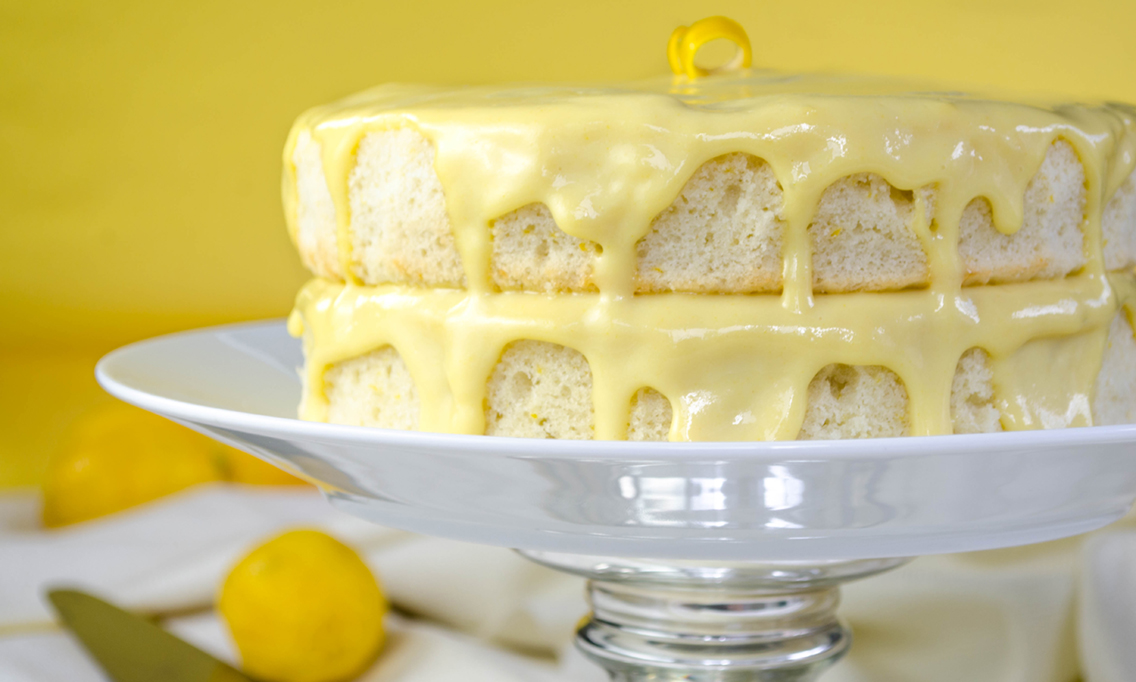Servings12
Time to Cook45 minutes
Time to Prepare60 minutes
This super simple cake uses a mix of “old-school” and “new-school” baking techniques and is pantry friendly! Plus, the cake uses egg whites while the luscious lemon curd topping uses the egg yolks so it’s a great no-waste recipe.
Instructions
Cake
- Line two 8 inch cake pans with a circle of parchment paper. Grease the sides with a little oil.
- Preheat oven to 350°F (176°C) and position the racks so that the cakes will sit in the middle.
- Combine the egg whites and salt in a large bowl or stand mixer, then whip to stiff peaks. Set aside.
- Combine the olive oil, lemon juice, vanilla, and sugar. Whip/whisk for about 2 minutes, or until thick and somewhat foamy/airy.
- Whisk flour, baking powder, and lemon zest together.
- Using the paddle attachment of a stand mixer (or hand beaters) at low speed, gently mix approximately 1/3 of the flour mixture into the whipped oil and sugar. Add 1/3 of the ice water, and continue to mix. Repeat with remaining flour and water, stopping when the ingredients are just barely mixed. The resulting batter should be fairly thick, but still liquid enough to pour.
- Gently fold the whipped egg whites by hand into the batter mixture, a little at a time. Work gently to avoid deflating the mixture.
- Pour the batter into the prepared pans. Bake for 45-50 minutes, or until a cake tester comes out clean. Cool for 10 minutes, then gently invert the cakes onto cooling racks and set them aside.
- Once the cakes have cooled, trip the tops (and sides, if you like) so they’re flat. Cover one layer of the cake with the finished/cooled curd, then top with the second layer and more curd. Cover and chill for 1 hour, then serve.
Lemon Curd
High Speed Blender Method
A high speed blender, like a Vitamix, is required for this method, as a regular blender does not bring the temperature of the eggs up enough to ensure they are “cooked” appropriately.
- Combine all the lemon curd ingredients in a high speed blender (e.g. a Vitamix) and mix at full speed for 5 minutes. Let stand for 2 minutes, then remove the lid and allow the lemon curd to cool.
Stove Top Method
No high speed blender? No problem!
- Prepare a double-boiler, or a medium-sized heat-proof bowl over a pot of simmering water.
- Whisk the lemon juice, olive oil, lemon zest, sugar and salt together in small bowl.
- Place the oil/lemon mixture in the double boiler. Whisk in the eggs. Heat over a low flame, stirring continuously, until the curd has thickened and set (around 12-15 minutes). When finished remove from heat and refrigerate for at least 1 hour.
Notes
Cake Flour vs. All-Purpose Flour – Cake flour is made from ‘soft’ (low-gluten) wheat varieties. The lower gluten content makes for a softer, finer crumb. All-purpose flours are generally a little higher in gluten content, but not as high as bread flour (though this can vary quite a bit). I had no issues with all-purpose flour, but if you find that the cake is a bit tougher or chewier than you like, consider seeking out cake flour instead.
Olive Oil – Extra virgin olive oil will contribute a fruity, somewhat grassy flavour and aroma to both the cake and the lemon curd. If you like olive oil (and I do), feel free to use extra virgin. That being said, make sure to use an olive oil you know and like – ideally one with a fruitier flavour profile. If you’d rather the olive oil not be noticeable in the final cake, use regular/virgin olive oil, or another light/neutral oil like canola, avocado, or grapeseed.
Lemon Curd Quantity – The recipe above makes more lemon curd than you’re likely to need for the cake. That being said, it’s easier just to use up the yolks from the cake recipe, and to keep the excess lemon curd in the fridge for later. It keeps very well in the fridge for 2+ weeks.

